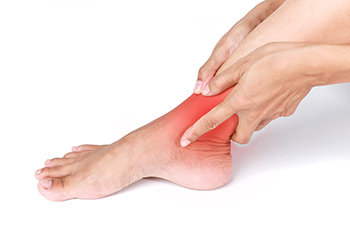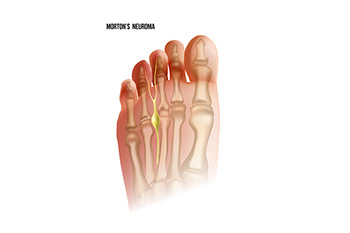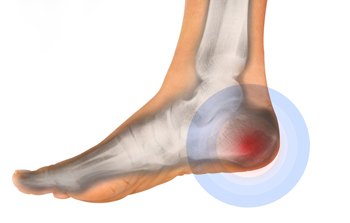
Blog (869)
Acute Ankle Sprains in Baseball Players

Acute ankle sprains are a frequent injury in professional and non-professional baseball due to the high physical demands of the sport. These sprains often result from sudden movements such as sliding into bases, pivoting quickly, or landing awkwardly after a jump. The most common type involves the lateral ligaments on the outside of the ankle, but sprains can also affect the inner or high ankle ligaments. Players may experience pain, swelling, bruising, and instability. Diagnosis begins with a thorough physical examination to assess tenderness, range of motion, and joint stability. Imaging such as X-rays or MRI scans may be used to rule out fractures and evaluate ligament damage. If an ankle injury has occurred while playing baseball, it is suggested that you promptly consult a podiatrist who can accurately diagnose and offer effective treatment solutions.
Sports related foot and ankle injuries require proper treatment before players can go back to their regular routines. For more information, contact one of our podiatrists of Westland Foot & Ankle Specialists, P.C.. Our doctors can provide the care you need to keep you pain-free and on your feet.
Sports Related Foot and Ankle Injuries
Foot and ankle injuries are a common occurrence when it comes to athletes of any sport. While many athletes dismiss the initial aches and pains, the truth is that ignoring potential foot and ankle injuries can lead to serious problems. As athletes continue to place pressure and strain the area further, a mild injury can turn into something as serious as a rupture and may lead to a permanent disability. There are many factors that contribute to sports related foot and ankle injuries, which include failure to warm up properly, not providing support or wearing bad footwear. Common injuries and conditions athletes face, including:
- Plantar Fasciitis
- Plantar Fasciosis
- Achilles Tendinitis
- Achilles Tendon Rupture
- Ankle Sprains
Sports related injuries are commonly treated using the RICE method. This includes rest, applying ice to the injured area, compression and elevating the ankle. More serious sprains and injuries may require surgery, which could include arthroscopic and reconstructive surgery. Rehabilitation and therapy may also be required in order to get any recovering athlete to become fully functional again. Any unusual aches and pains an athlete sustains must be evaluated by a licensed, reputable medical professional.
If you have any questions please feel free to contact our office located in Westland, MI. . We offer the newest diagnostic and treatment technologies for all your foot and ankle needs.
What Are Plantar Warts?

Plantar warts are growths that appear on the soles of the feet, caused by the human papillomavirus, or HPV. They often develop in areas of pressure, like the heel or ball of the foot, and can sometimes combine to form a condition known as mosaic warts. Mosaic warts are clusters of multiple warts that spread out across a larger area, creating a patchy, rough surface. These warts can cause pain, especially when walking or standing for long periods. They often look like small, rough bumps with black dots in the center, which are blood vessels. The area susrrounding the wart may become hardened and calloused. A podiatrist can diagnose and treat plantar warts through various methods, including cryotherapy or freezing, laser treatment, and minor surgery. They may also provide topical treatments and advice on preventing the spread of the virus. If you have this condition, it is suggested that you schedule an appointment with a podiatrist for appropriate care.
Plantar warts can be very uncomfortable. If you need your feet checked, contact one of our podiatrists from Westland Foot & Ankle Specialists, P.C.. Our doctors will assist you with all of your foot and ankle needs.
About Plantar Warts
Plantar warts are the result of HPV, or human papillomavirus, getting into open wounds on the feet. They are mostly found on the heels or balls of the feet.
While plantar warts are generally harmless, those experiencing excessive pain or those suffering from diabetes or a compromised immune system require immediate medical care. Plantar warts are easily diagnosed, usually through scraping off a bit of rough skin or by getting a biopsy.
Symptoms
- Lesions on the bottom of your feet, usually rough and grainy
- Hard or thick callused spots
- Wart seeds, which are small clotted blood vessels that look like little black spots
- Pain, discomfort, or tenderness of your feet when walking or standing
Treatment
- Freezing
- Electric tool removal
- Laser Treatment
- Topical Creams (prescription only)
- Over-the-counter medications
To help prevent developing plantar warts, avoid walking barefoot over abrasive surfaces that can cause cuts or wounds for HPV to get into. Avoiding direct contact with other warts, as well as not picking or rubbing existing warts, can help prevent the further spread of plantar warts. However, if you think you have developed plantar warts, speak to your podiatrist. He or she can diagnose the warts on your feet and recommend the appropriate treatment options.
If you have any questions please feel free to contact our office located in Westland, MI. . We offer the newest diagnostic and treatment technologies for all your foot and ankle needs.
Causes and Common Locations of Seed Corns

Seed corns are small, hardened areas of skin that develop on the feet due to repeated friction and pressure. They appear as tiny, round calluses with a central core and often form on weight-bearing areas. These corns commonly develop on the ball of the foot, the bottom of the heel, or the sides of the toes. Causes include wearing tight or ill-fitting shoes, excessive walking or running, and dry skin that lacks natural protection. Unlike larger corns, seed corns can be tender and may cause discomfort when pressure is applied. Keeping the feet moisturized, wearing well-fitted shoes, and using protective padding can help prevent their formation. Seed corns can be painful, and may cause difficulty in completing daily activities. If you have corns on your feet, it is suggested that you visit a podiatrist who can offer effective relief and treatment solutions.
If you have any concerns regarding your feet and ankles, contact one of our podiatrists of Westland Foot & Ankle Specialists, P.C.. Our doctors will treat your foot and ankle needs.
Corns: What Are They? and How Do You Get Rid of Them?
Corns can be described as areas of the skin that have thickened to the point of becoming painful or irritating. They are often layers and layers of the skin that have become dry and rough, and are normally smaller than calluses.
Ways to Prevent Corns
There are many ways to get rid of painful corns such as wearing:
- Well-fitting socks
- Comfortable shoes that are not tight around your foot
- Shoes that offer support
Treating Corns
Treatment of corns involves removing the dead skin that has built up in the specific area of the foot. Consult with Our doctors to determine the best treatment option for your case of corns.
If you have any questions please feel free to contact our office located in Westland, MI. . We offer the newest diagnostic and treatment technologies for all your foot and ankle needs.
Arthritis Can Cause Pain in the Feet and Ankles
Dangers of Gangrene in Diabetic Patients

Gangrene is a serious condition that occurs when tissue dies due to a lack of blood flow or an infection. People with diabetes are at a higher risk of developing gangrene, particularly in the feet, toes, and ankles, as a result of poor circulation and a reduced ability to heal wounds. High blood sugar can damage nerves, leading to loss of sensation, which makes it difficult to detect injuries. Small cuts, blisters, or ulcers may go unnoticed, increasing the chance of infection. If an infection worsens, tissue death can occur, and surgery may be required to remove the affected area. Signs of gangrene include skin discoloration, swelling, foul-smelling discharge, and numbness. If left untreated, the infection can spread and lead to severe complications. A podiatrist can help by identifying foot problems early, treating wounds before they worsen, and recommending strategies to improve circulation. Regular foot exams are essential for preventing complications like gangrene. If you have diabetes and suffer from foot ulcers, it is suggested that you schedule regular appointments with a podiatrist for checkups and appropriate care.
Diabetic foot care is important in preventing foot ailments such as ulcers. If you are suffering from diabetes or have any other concerns about your feet, contact one of our podiatrists from Westland Foot & Ankle Specialists, P.C.. Our doctors can provide the care you need to keep you pain-free and on your feet.
Diabetic Foot Care
Diabetes affects millions of people every year. The condition can damage blood vessels in many parts of the body, especially the feet. Because of this, taking care of your feet is essential if you have diabetes, and having a podiatrist help monitor your foot health is highly recommended.
The Importance of Caring for Your Feet
- Routinely inspect your feet for bruises or sores.
- Wear socks that fit your feet comfortably.
- Wear comfortable shoes that provide adequate support.
Patients with diabetes should have their doctor monitor their blood levels, as blood sugar levels play such a huge role in diabetic care. Monitoring these levels on a regular basis is highly advised.
It is always best to inform your healthcare professional of any concerns you may have regarding your feet, especially for diabetic patients. Early treatment and routine foot examinations are keys to maintaining proper health, especially because severe complications can arise if proper treatment is not applied.
If you have any questions please feel free to contact our office located in Westland, MI. . We offer the newest diagnostic and treatment technologies for all your foot and ankle needs.
Facts About Eversion Ankle Sprains

An eversion ankle sprain happens when the ankle rolls outward, stretching or tearing the deltoid ligaments on the inner side of the joint. This contrasts with the more common inversion sprain, where the ankle rolls inward, affecting the ligaments on the outer side. Eversion ankle sprains are often more severe because the deltoid ligaments are strong and require greater force to cause injury. An eversion ankle sprain can result from landing awkwardly, sudden directional changes, or twisting motions where the foot moves outward while the leg rotates inward. Symptoms include pain, swelling, and bruising on the inner ankle, whereas inversion sprains typically cause discomfort on the outer side. Eversion sprains also have a higher risk of injuries that affect the ligaments connecting the tibia and fibula above the ankle joint. These types of injuries can make walking difficult and may require extended healing time. A podiatrist can assess the severity, check for fractures, and determine if a cast, boot, or surgery is necessary. If you have sprained an ankle, it is suggested that you schedule an immediate appointment with a podiatrist for an exam, diagnosis, and treatment options.
Although ankle sprains are common, they aren’t always minor injuries. If you need your ankle injury looked at, contact one of our podiatrists from Westland Foot & Ankle Specialists, P.C.. Our doctors can provide the care you need to keep you pain-free and on your feet.
How Does an Ankle Sprain Occur?
Ankle sprains are the result of a tear in the ligaments within the ankle. These injuries may happen when you make a rapid shifting movement while your foot is planted. A less common way to sprain your ankle is when your ankle rolls inward while your foot turns outward.
What Are the Symptoms?
- Pain at the sight of the tear
- Bruising/Swelling
- Ankle area is tender to touch
- In severe cases, may hear/feel something tear
- Skin discoloration
Preventing a Sprain
- Wearing appropriate shoes for the occasion
- Stretching before exercises and sports
- Knowing your limits
Treatment of a Sprain
In many cases, the RICE method (Rest, Ice, Compression, and Elevate) is used to treat ankle sprains. However, you should see a podiatrist to see which treatment option would work best with your injury. In severe cases, surgery may be required.
It is important to ask your doctor about rehab options after you receive treatment for your injury. Stretching, strength training, and balance exercises may help the ankle heal while also preventing further injury.
If you have any questions, please feel free to contact our office located in Westland, MI. . We offer the newest diagnostic and treatment technologies for all your foot care needs.
Possible Causes of Sudden Ankle Pain

Sudden ankle pain without an obvious injury can stem from various conditions, including arthritis, autoimmune diseases, and structural issues in the foot. Osteoarthritis develops over time from joint wear, while rheumatoid arthritis and lupus can cause inflammation in both ankles. Reactive arthritis, often triggered by an infection, leads to joint pain and swelling. Gout, caused by excess uric acid, can bring sudden, severe pain to the ankle joints. Flat feet or posterior tibial tendon dysfunction can strain the ankle, causing discomfort and instability. Additionally, bursitis, an inflammation of fluid-filled sacs near the joint, can cause swelling and tenderness. A podiatrist can identify the root cause of your ankle pain through a thorough examination and diagnostic tests. They can recommend supportive footwear, provide custom orthotics, and suggest targeted exercises or medication to relieve pain and improve mobility. In some cases, surgery may be advised. If you are experiencing sudden ankle pain, it is suggested that you schedule an appointment with a podiatrist for appropriate treatment.
Ankle pain can be caused by a number of problems and may be potentially serious. If you have ankle pain, consult with one of our podiatrists from Westland Foot & Ankle Specialists, P.C.. Our doctors will assess your condition and provide you with quality foot and ankle treatment.
Ankle pain is any condition that causes pain in the ankle. Due to the fact that the ankle consists of tendons, muscles, bones, and ligaments, ankle pain can come from a number of different conditions.
Causes
The most common causes of ankle pain include:
- Types of arthritis (rheumatoid, osteoarthritis, and gout)
- Ankle sprains
- Broken ankles
- Achilles tendonitis
- Achilles tendon rupture
- Stress fractures
- Bursitis
- Tarsal tunnel syndrome
- Plantar fasciitis
Symptoms
Symptoms of ankle injury vary based upon the condition. Pain may include general pain and discomfort, swelling, aching, redness, bruising, burning or stabbing sensations, and/or loss of sensation.
Diagnosis
Due to the wide variety of potential causes of ankle pain, podiatrists will utilize a number of different methods to properly diagnose ankle pain. This can include asking for personal and family medical histories and of any recent injuries. Further diagnosis may include sensation tests, a physical examination, and potentially x-rays or other imaging tests.
Treatment
Just as the range of causes varies widely, so do treatments. Some more common treatments are rest, ice packs, keeping pressure off the foot, orthotics and braces, medication for inflammation and pain, and surgery.
If you have any questions, please feel free to contact our office located in Westland, MI. . We offer the newest diagnostic and treatment technologies for all your foot care needs.
Gout Pain Can Be Managed
Are Orthotics Right for You?

Custom orthotics can help alleviate foot pain, improve alignment, and support mobility, but not everyone needs them. If you are experiencing persistent discomfort, instability, or issues related to gait, a podiatrist can determine if orthotics are the right solution. Before your appointment, take note of your symptoms, when they occur, and what activities make them worse. Bring your most frequently worn shoes and any previous orthotics if you have them. Your podiatrist will assess your foot structure, walking pattern, and overall biomechanics, and may recommend custom orthotics tailored to your needs. Be prepared to discuss your lifestyle, activity level, and any underlying conditions like diabetes or arthritis that may impact your foot health. If you are having foot problems, it is suggested that you visit a podiatrist for an evaluation and treatment options, which may include orthotics.
If you are having discomfort in your feet and would like to try orthotics, contact one of our podiatrists from Westland Foot & Ankle Specialists, P.C.. Our doctors can provide the care you need to keep you pain-free and on your feet.
What Are Orthotics?
Orthotics are inserts you can place into your shoes to help with a variety of foot problems such as flat feet or foot pain. Orthotics provide relief and comfort for minor foot and heel pain but can’t correct serious biomechanical problems in your feet.
Over-the-Counter Inserts
Orthotics come in a wide variety of over-the-counter inserts that are used to treat foot pain, heel pain, and minor problems. For example, arch supports can be inserted into your shoes to help correct overarched or flat feet, while gel insoles are often used because they provide comfort and relief from foot and heel pain by alleviating pressure.
Prescription Orthotics
If over-the-counter inserts don’t work for you or if you have a more severe foot concern, it is possible to have your podiatrist prescribe custom orthotics. These high-quality inserts are designed to treat problems such as abnormal motion, plantar fasciitis, and severe forms of heel pain. They can even be used to help patients suffering from diabetes by treating foot ulcers and painful calluses and are usually molded to your feet individually, which allows them to provide full support and comfort.
If you are experiencing minor to severe foot or heel pain, it’s recommended to speak with your podiatrist about the possibilities of using orthotics. A podiatrist can determine which type of orthotic is right for you and allow you to take the first steps towards being pain-free.
If you have any questions please contact our office located in Westland, MI. . We offer the newest diagnostic and treatment technologies for all your foot and ankle needs.
Causes and Symptoms of Morton’s Neuroma

Morton’s neuroma is a condition that causes pain in the ball of the foot, typically between the third and fourth toes. It occurs when the tissue around a nerve becomes thickened, leading to irritation and discomfort. The exact cause of Morton’s neuroma is not always clear, but it is commonly linked to repetitive stress or pressure on the foot, such as from wearing tight shoes or engaging in high-impact activities. Symptoms often include sharp, burning pain, a feeling of something being stuck in the shoe, and numbness in the affected toes. The pain may worsen when walking or standing for long periods. If you have pain in this part of your foot, it is suggested that you consult a podiatrist who can accurately diagnose and treat what may be going on.
Morton’s neuroma is a very uncomfortable condition to live with. If you think you have Morton’s neuroma, contact one of our podiatrists of Westland Foot & Ankle Specialists, P.C.. Our doctors will attend to all of your foot care needs and answer any of your related questions.
Morton’s Neuroma
Morton's neuroma is a painful foot condition that commonly affects the areas between the second and third or third and fourth toe, although other areas of the foot are also susceptible. Morton’s neuroma is caused by an inflamed nerve in the foot that is being squeezed and aggravated by surrounding bones.
What Increases the Chances of Having Morton’s Neuroma?
- Ill-fitting high heels or shoes that add pressure to the toe or foot
- Jogging, running or any sport that involves constant impact to the foot
- Flat feet, bunions, and any other foot deformities
Morton’s neuroma is a very treatable condition. Orthotics and shoe inserts can often be used to alleviate the pain on the forefront of the feet. In more severe cases, corticosteroids can also be prescribed. In order to figure out the best treatment for your neuroma, it’s recommended to seek the care of a podiatrist who can diagnose your condition and provide different treatment options.
If you have any questions, please feel free to contact our office located in Westland, MI. . We offer the newest diagnostic and treatment technologies for all your foot care needs.
More...
Types of Foot Surgery

Foot surgery can be performed on the joint of the big toe, the joints in the middle of the foot, the joints in the lesser toes, or the joints beneath the ankle when pain and mobility issues interfere with daily life. Fusion surgery, or arthrodesis, is often used for severe arthritis, where two or more bones are secured together with screws or plates to eliminate painful joint movement. Debridement, or cheilectomy, is a procedure that removes excess bone and tissue in the big toe joint to improve range of motion and relieve discomfort caused by bone spurs. Osteotomy is commonly performed for bunions, involving precise bone cuts to correct misalignment and stabilize the toe with screws or pins. Hemiarthroplasty is another option for arthritis in the big toe joint, where a synthetic implant is inserted to restore movement and reduce pain. A podiatrist can assess your particular foot problem and determine the most appropriate surgical approach. If you are experiencing foot pain, it is suggested that you schedule an appointment with a podiatrist for a diagnosis and appropriate treatment options.
Foot surgery is sometimes necessary to treat a foot ailment. To learn more, contact one of our podiatrists of Westland Foot & Ankle Specialists, P.C.. Our doctors will assist you with all of your foot and ankle needs.
When Is Surgery Necessary?
Foot and ankle surgery is generally reserved for cases in which less invasive, conservative procedures have failed to alleviate the problem. Some of the cases in which surgery may be necessary include:
- Removing foot deformities like bunions and bone spurs
- Severe arthritis that has caused bone issues
- Cosmetic reconstruction
What Types of Surgery Are There?
The type of surgery you receive will depend on the nature of the problem you have. Some of the possible surgeries include:
- Bunionectomy for painful bunions
- Surgical fusion for realignment of bones
- Neuropathy decompression surgery to treat nerve damage
Benefits of Surgery
Although surgery is usually a last resort, it can provide more complete pain relief compared to non-surgical methods and may allow you to finally resume full activity.
Surgical techniques have also become increasingly sophisticated. Techniques like endoscopic surgery allow for smaller incisions and faster recovery times.
If you have any questions please feel free to contact our office located in Westland, MI. . We offer the newest diagnostic and treatment technologies for all your foot and ankle needs.
Are Bunions Affecting Your Everyday Life?
Reasons for Heel Pain After Running

Heel pain after running is a common complaint among runners and can stem from various foot conditions. Plantar fasciitis, one of the leading causes of heel pain after running, occurs when the thick tissue on the bottom of the foot becomes strained from repetitive impact. Other potential sources of heel pain are Achilles tendinitis, stress fractures, or heel spurs, which may develop due to excessive strain on the heel. Running on hard surfaces, wearing improper footwear, or sudden increases in training intensity can contribute to the problem. Symptoms include sharp pain in the heel, stiffness in the ankle, and tenderness along the arch or Achilles tendon. If left untreated, the heel pain can worsen, making daily activities like standing and walking more difficult. A podiatrist can evaluate the underlying cause of heel pain, recommend treatment to relieve discomfort, and offer guidance on proper footwear and running techniques to reduce strain on the feet. If you experience heel pain after running, it is suggested that you schedule an appointment with a podiatrist for an exam and appropriate treatment.
Many people suffer from bouts of heel pain. For more information, contact one of our podiatrists of Westland Foot & Ankle Specialists, P.C.. Our doctors can provide the care you need to keep you pain-free and on your feet.
Causes of Heel Pain
Heel pain is often associated with plantar fasciitis. The plantar fascia is a band of tissues that extends along the bottom of the foot. A rip or tear in this ligament can cause inflammation of the tissue.
Achilles tendonitis is another cause of heel pain. Inflammation of the Achilles tendon will cause pain from fractures and muscle tearing. Lack of flexibility is also another symptom.
Heel spurs are another cause of pain. When the tissues of the plantar fascia undergo a great deal of stress, it can lead to ligament separation from the heel bone, causing heel spurs.
Why Might Heel Pain Occur?
- Wearing ill-fitting shoes
- Wearing non-supportive shoes
- Weight change
- Excessive running
Treatments
Heel pain should be treated as soon as possible for immediate results. Keeping your feet in a stress-free environment will help. If you suffer from Achilles tendonitis or plantar fasciitis, applying ice will reduce the swelling. Stretching before an exercise like running will help the muscles. Using all these tips will help make heel pain a condition of the past.
If you have any questions please contact our office located in Westland, MI. . We offer the newest diagnostic and treatment technologies for all your foot and ankle needs.
Causes of Purple Feet in the Elderly

Purple feet in the elderly can be a concerning sign and may arise from several underlying conditions. One common cause is neuropathy, a condition where nerve damage disrupts normal circulation, leading to poor blood flow and discoloration in the extremities. Acrocyanosis is another possibility, a condition characterized by persistent blue or purple coloration in the hands and feet, often linked to cold temperatures or poor circulation. Artery blockages, which occur when plaque or other substances narrow the blood vessels, can also restrict blood flow and cause the feet to turn purple. In some cases, medication side effects may contribute to changes in circulation, with certain drugs affecting blood vessels or causing fluid retention. Regardless of the cause, it is important for elderly individuals to seek medical attention from a podiatrist if they notice purple feet, as early intervention can help prevent more serious complications. If you are a senior citizen or are caring for an elderly person, it is suggested that you consult this type of doctor for professional foot care needs.
Proper foot care is something many older adults forget to consider. If you have any concerns about your feet and ankles, contact one of our podiatrists from Westland Foot & Ankle Specialists, P.C.. Our doctors can provide the care you need to keep you pain-free and on your feet.
The Elderly and Their Feet
As we age we start to notice many changes in our body, but the elder population may not notice them right away. Medical conditions may prevent the elderly to take notice of their foot health right away. Poor vision is a lead contributor to not taking action for the elderly.
Common Conditions
- Neuropathy – can reduce feeling in the feet and can hide many life-threatening medical conditions.
- Reduced flexibility – prevents the ability of proper toenail trimming, and foot cleaning. If left untreated, it may lead to further medical issues.
- Foot sores – amongst the older population can be serious before they are discovered. Some of the problematic conditions they may face are:
- Gouging toenails affecting nearby toe
- Shoes that don’t fit properly
- Pressure sores
- Loss of circulation in legs & feet
- Edema & swelling of feet and ankles
Susceptible Infections
Diabetes and poor circulation can cause general loss of sensitivity over the years, turning a simple cut into a serious issue.
If you have any questions please feel free to contact our office located in Westland, MI. . We offer the newest diagnostic and treatment technologies for all your foot and ankle needs.



